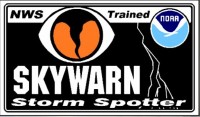|
GREAT FOR CAMPING OR EMERGENCY COMMUNICATIONS
|
|||||||||||||||||||||||||||||||||||||
|
BOB HEJL – W2IK
|
|||||||||||||||||||||||||||||||||||||
|
EVER WISH YOU HAD A VERY SIMPLE, LIGHT WEIGHT HAM RADIO ANTENNA THAT COULD BE STUFFED IN YOUR BACKPACK AND DOES NOT NEED A TUNER? HERE IS A SIMPLE DESIGN THAT I BUILT MANY YEARS AGO AND FOUND IT TO BE VERY USEFUL WHILE CAMPING OR FOR EMERGENCY COMMUNICATIONS. IT’S GREAT IF YOU DON’T HAVE THE ABILITY TO TAKE ALONG MY “IK-STIC 2″ANTENNA (TO BUILD THAT ANTENNA, SEE ANOTHER POSTING ON THIS SITE.
|
|||||||||||||||||||||||||||||||||||||
|
WHEN YOU ARE CAMPING, YOU HAVE TO MAKE COMPROMISES. THE SAME IS TRUE ABOUT CAMPINGWITH HAM RADIO. USUALLY YOU’LL BE OPERATING ON 20 METERS IN THE DAY AND 40 METERS AT NIGHT. THAT BEING SAID, I DEVISED A VERY SIMPLE ANTENNA IN A SINGLE FORM THAT WILL COVER BOTH BANDS WITHOUT THE NEED FOR A TUNER.
|
|||||||||||||||||||||||||||||||||||||
|
TO BUILD THIS ANTENNA YOU WILL NEED
50 FEET OF 450 – 600 OHM LADDER LINE (NOT TWIN LEAD)
2 THREE INCH PIECES OF 1/2 INCH PVC TUBING
ONE CENTER CONNECTOR (DIPOLE TYPE-WIRE TO SO-239 CONNECTOR)
|
|||||||||||||||||||||||||||||||||||||
|
UNROLL THE COIL OF LADDER LINE AND CUT THE LADDER LINE IN HALF SO YOU HAVE TWO LENGTHS EXACTLY 25 FEET LONG. EACH LENGTH BECOMES A SIDE OF YOUR DIPOLE SYSTEM. AT THE EVERY END OF EACH WIRE, STRIP OFF THE INSULATION EXPOSING ABOUT 4 INCHES OF BARE WIRE. ON ONE SIDE OF EACH LADDER LINE TWIST THE BARE WIRES TOGETHER AND SOLDER ONE END OF EACH LADDER LINE TO THE WIRES ON THE CENTER CONNECTOR.
(SEE PICTURE BELOW)
|
|||||||||||||||||||||||||||||||||||||
 |
|||||||||||||||||||||||||||||||||||||
|
AT THE OTHER END OF EACH OF THE LENGTHS OF LADDER LINE, TAKE ONE PIECE OF 1/2 INCH PVCTUBE AND SLIDE THE WIRES THROUGH 1/4 INCH HOLE DRILLED NEAR ONE END OF THE PVC TUBE. PULL THE PVC AROUND SO YOU CAN CONNECT THE WIRES TO EACH OTHER AND SOLDER THEM TOGETHER.
(SEE PHOTO OF THE ONE OF THE TWO END INSULATORS BELOW)
DRILL ANOTHER 1/4 INCH HOLE ON THE OTHER END OF THE PVC TUBE SO YOU CAN HANG THE DIPOLE SYSTEM UP USING NYLON CORD.
|
|||||||||||||||||||||||||||||||||||||
 |
|||||||||||||||||||||||||||||||||||||
|
THE SPECIAL CUT
|
|||||||||||||||||||||||||||||||||||||
|
NOW JUST ONE MORE THING TO DO. IN ORDER TO MAKE THIS A 40 AND 20 METER ANTENNA, YOU NEED TO MEASURE 16.4 FEET FROM THE MIDDLE OF THE CENTER CONNECTOR AND ON ONE WIRE OF EACH SIDE OF THE LADDER LINE YOU WILL CLIP OUT A 1/4 INCH SECTION OF WIRE. IF POSSIBLE, CLIP THE SECTION OUT WHERE THERE IS A SEPARATING PIECE OF THE LADDER LINE WEBBING SO THE ANTENNA WILL BE PHYSICALLY MORE STABLE.
THIS WILL LEAVE YOU WITH TWO ANTENNAS IN ONE SYSTEM. ONE ANTENNA’S TOTAL DIPOLE LENGTH IS 32.8 FEET (16.4 FEET ON EACH DIPOLE LEG) OR A 20 METER DIPOLE, AND THE OTHER IS THE 40 METER DIPOLE AS THE WIRE IN LADDER LINE YOU DIDN’T CLIP WILL NOW RUN THE ENTIRE LENGTH OF EACH SIDE, CONTINUE AROUND THE END INSULATORS AND CONTINUE IN A HAIRPIN RUN AROUND TO THE OTHER (LOWER) SIDE OF THE LADDER LINE ON THAT SAME SIDE MAKING A LENGTH OF ABOUT 66.8 FEET TOTAL OR 33.4 FEET ON EACH LEG (LESS THAN THE MATH OF JUST ADDING AND SUBTRACTING BECAUSE YOU LOST LENGTH WHEN YOU SOLDERED THE WIRES THAT ARE IN THE END CONNECTORS) THIS IS FINE FOR A 40 METER DIPOLE.
THERE IS JUST A LITTLE INTERACTION WITH THE TWO ANTENNAS SO CLOSE TOGETHER. IF YOU WISH TO BE REALLY FUSSY, YOU MAY WANT TO DO THE WIRE CLIP ACTION AND CHECK THE TUNING USING AN ANTENNA ANALYZER. IF THIS IS THE CASE, DO NOT CLIP OUT A 1/4 INCH PIECE YET, JUST CLIP THE WIRE, MEASURE THE SWR WITH THE ANTENNA HUNG AND MAKE ANY CORRECTIONS (DO THIS BYRESOLDERING THE CUT YOU MADE AND MAKE ANOTHER CUT DEPENDING UPON THE ANTENNA’SRESONANT FREQUENCY). ALTHOUGH THIS ANTENNA IS NOT AS EFFICIENT ON 40 METERS AS A DIPOLESTRUNG OUT INSTEAD OF FOLDED, I HAVE USED THIS ANTENNA ON MANY OUTINGS WITH GREATRESULTS AND IT IS MORE CONVIENT TO PUT UP OR STORE. YOU CAN EASILY COIL IT UP AND STORE INYOUR BACK PACK. IT CAN BE PUT UP AS A DIPOLE, SLOPER OR INVERTED “V”. MAKE SURE YOU HAVENON-CONDUCTING CORD TO HANG IT UP. AND BY THE WAY, SINCE THE 40 METER SECTION LOOPSAROUND, ALL YOU NEED IS 52 FEET BETWEEN TREES TO HANG THIS ANTENNA AS A DIPOLE!!!
|
|||||||||||||||||||||||||||||||||||||
 |
|||||||||||||||||||||||||||||||||||||
|
LADDER LINE ANTENNA
COILED UP FOR STORING IN ABACK PACK SO IT CAN BE USEDWHILE HIKING OR CAMPING
|
|||||||||||||||||||||||||||||||||||||
|
ALL DESIGNS COPYRIGHTED
BY W2IK – BOB HEJL
MY NOT BE USED WITHOUT
AUTHOR CREDIT
|
|||||||||||||||||||||||||||||||||||||








 Here is a link to a movie trailer I made from video and photos of my Skywarn Spotting Activities over the past year.
Here is a link to a movie trailer I made from video and photos of my Skywarn Spotting Activities over the past year.